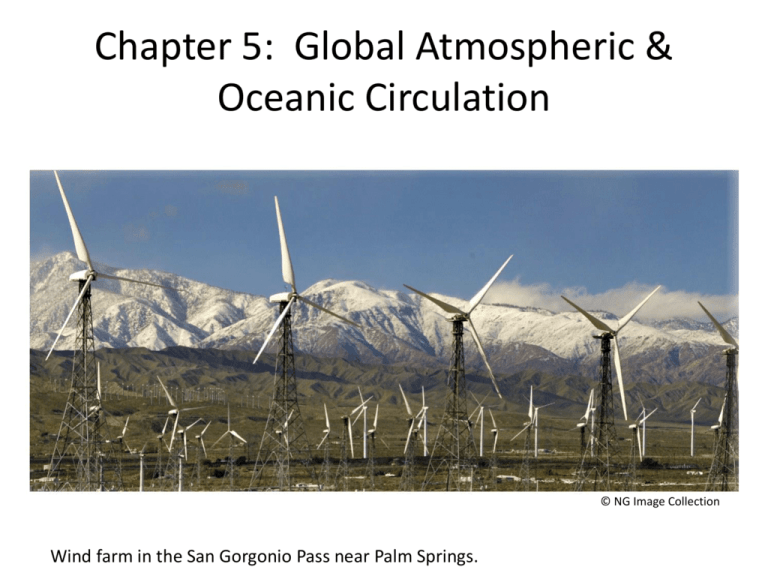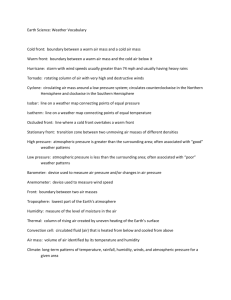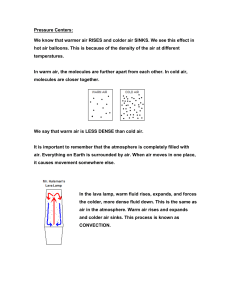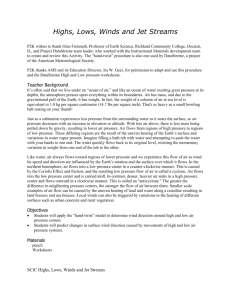Chapter 5
advertisement

Chapter 5: Global Atmospheric & Oceanic Circulation © NG Image Collection Wind farm in the San Gorgonio Pass near Palm Springs. Atmospheric Pressure • Atmospheric pressure is pressure exerted by the atmosphere because of the force of gravity acting on the overlying column of air. • 15lbs per square inch • Measuring Atmospheric Pressure • Units = inches of mercury (in. Hg) or millibars (mb). • Standard sea level pressure = 1013.2 mb. • Barometer is an instrument that measures atmospheric pressure. • Height of mercury: 76cm Hg standard © John Wiley & Sons ,Inc Atmospheric Pressure and Altitude • Ever felt your ears pop? • Pressure is determined by the mass of air molecules above that elevation • The more mass, the higher the pressure • Air density also depends on pressure and temperature. • Atmospheric pressure decreases with altitude. Density decreases with altitude. © John Wiley & Sons, Inc. Atmospheric Pressure & Wind Wind: • Horizontal movement of air • Renewable resource • Measured with an anemometer Wind direction: • Identified by the direction from which the wind comes • West wind blows from west to east Combination cup anemometer and wind vane. Wind speed and direction are displayed on the meter. Wind speed and direction: determined by three factors: pressure gradient, Coriolis effect, and friction. Pressure Gradients Pressure Gradients • Caused by differences in pressure from region to region • Air is pushed down the gradient (from higher to lower pressure) • Causes of pressure gradients? • Uneven heating of the atmosphere—why? © John Wiley & Sons, Inc. Pressure Gradients • Isobar = line on a map drawn through all points having the same atmospheric pressure • Widely spaced isobars weak gradient and weaker winds. • Closely spaced isobars strong PG and stronger winds. Where would you find the greatest pressure gradient on this map? a. Oklahoma City b. Southwestern Missouri c. Memphis d. Nashville © John Wiley & Sons, Inc. Pressure Gradients • Unequal heating of the Earth’s surface leads to a pressure gradient and causes wind. • Latitude, terrain differences, and land cover can cause uneven heating, pressure gradients and wind. If the island were in the Arctic and covered by glacial ice, would the pressure gradient be the same or different? 1 2 3 © John Wiley & Sons, Inc. Coriolis Effect • The Coriolis Effect (CE) • An effect of the Earth’s rotation that acts like a force to deflect a moving object on the Earth’s surface to the: • Right in the northern hemisphere • Left in the southern hemisphere Coriolis Effect Animation Global Winds & Pressure Patterns In an ideal model, warm air at the equator rises, expands and creates a belt of low pressure. Colder air at the poles, is denser, moves along the pressure gradient toward the equator. Disrupted by variability in insolation due to: seasons land/water contrasts © John Wiley & Sons, Inc. Pressure and Winds in the Tropics Warm air rises along the equator, but never makes it to the poles to sink. The Coriolis Effect pulls it eastward and causes it to sink at about 30 degrees. Hadley Cell. The ITCZ is the low pressure along the equator, very light winds. The ITCZ migrates seasonally. When is it farthest north? South? What happens to the ITCZ near Asia? © John Wiley & Sons, Inc. ITCZ’s migration is intensified over Asia. Huge land/water temperature contrasts. Wet monsoons….dry monsoons? © NG Image Collection © John Wiley & Sons, Inc. North American monsoons? Warm air from Gulf of Mexico tends to move northward and westward into the Southwestern states (Arizona, Nevada, New Mexico). In winter, air flow has reversed bringing dry continental air from Canada south and eastward. Pressure and Winds in the Subtropics • Very large and stable anticyclones • Dry conditions • Migrate seasonally – Hawaiian high and Azores high – Strongest in our summer months – Weaken and move south in winter • Different influences for each Midlatitude Winds and Pressure Patterns • Westerlies: prevailing winds, from the subtropical high anticyclone • Polar front—boundary between cold and warm air masses, air is being lifted (frontal lifting), creating low pressure • Jet stream—upper air westerlies Jet stream disturbances • Rossby waves • Zonal flow (west to east) In northern hemisphere winter, air spirals outward from the strong Siberian high and its weaker cousin, the Canadian high. The Icelandic low and Aleutian low spawn winter storm systems that move southward and eastward on to the continents. In the southern hemisphere summer, air converges toward a narrow low pressure belt around the south polar high. In northern hemisphere summer, the continents show generally low-surface pressure, and high pressure builds over the oceans. The strong Asiatic low brings warm, moist Indian Ocean air over India and Southeast Asia. A weaker low forms over the deserts of the southwestern U.S. and northwestern Mexico. Outspiraling winds from the Hawaiian high and Azores high keep the west coasts of North America and Asia warm and dry, and the east coasts of North America and Asia warm and moist. In the southern hemisphere summer, the pattern is little different from winter, although pressure gradients are stronger. Local Winds • Daily Cycle of Winds – Sea breeze: during the day when land begins to warm more than ocean waters, creates low pressure over land, pulling in air from the sea – Land breeze: during evening, reversal of above – Valley breeze: during day air over mountain slopes becomes warmer than air at the valley floor, creating low pressure, pulling air up mountain slopes from the valley – Mountain breeze: during evening, reversal of above • Topographic Winds – Santa Anas: air drains from high-pressure in the Great Basin (between Rockies and Sierras), dry air flows downhill toward coast, warms adiabatically, rapidly dries-out the landscape Ocean Currents Oceanic Circulation Ocean Currents • A persistent, dominantly horizontal flow of water controlled by wind patterns • Gyres: large circular ocean movements © John Wiley & Sons, Inc What relationship do you notice with the northern hemisphere ocean current and the pressure type typically located at 30o N? Oceanic Circulation Ocean Currents Ocean circulation and energy transport: • Warm surface waters in the tropics move poleward. • Thermohaline circulation: Cold and dense waters in the N. Atlantic sink, flow equatorward, and eventually upwell to the surface at far distant locations to cool surrounding regions and complete the circuit. © NG Maps





